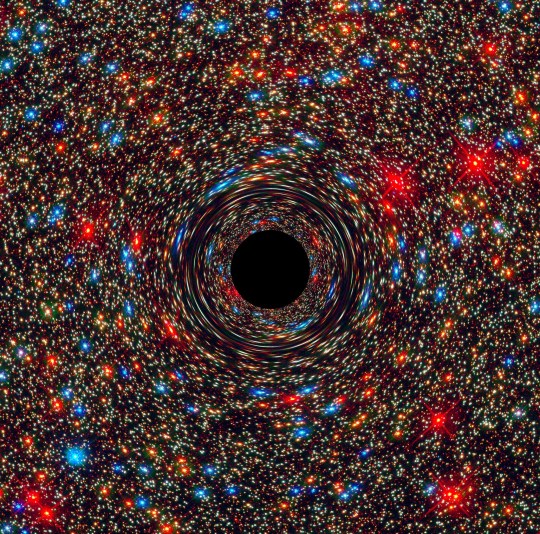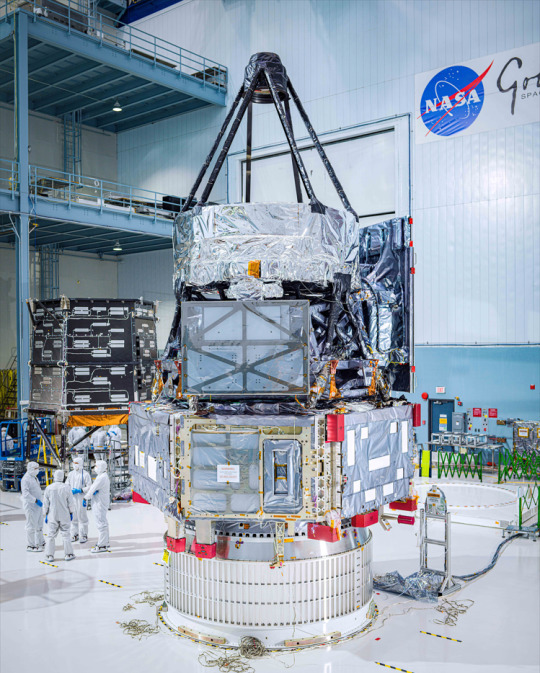Don't wanna be here? Send us removal request.
Text

Spinoffs: Space Station Innovations in Your Cart (and Heart!)
You might think NASA technology is just spaceships and telescopes, but did you know the camera in your cell phone is, too? It’s one of many NASA innovations now found everywhere on Earth.
The International Space Station has had crew living on it for 25 years straight. In that time, the space station has enabled a tremendous amount of research, helping NASA and scientists better understand long-term living in space – but it’s not just knowledge coming back down to Earth! Technologies developed for the space station and experiments conducted aboard the orbiting lab also benefit people on the planet below. Here are a few of these inventions, or spinoffs, you can find in your everyday life.

A Sunscreen That Blocks Radiation in Space – and on Your Face
After surviving for 18 months outside the International Space Station, an extremely hardy organism is now improving sunscreens and face cream products from a cosmetics company, which licensed use of the organism from NASA’s Jet Propulsion Laboratory.


Build Muscle With or Without Gravity
Muscles atrophy quickly in space, so when astronauts began long stays on the International Space Station, they needed some specialized exercise equipment. A resistance mechanism made of a coiled metal spring formed the basis of the first way for astronauts to “lift weights” in space. Soon after, that same design became the heart of compact home gym equipment.

Fresh Greens Every Day of the Year
The need to grow fresh food in space pushed NASA to develop indoor agriculture techniques. Thanks to the agency’s research, private companies are building on NASA’s vertical farm structure, plant-growth “recipes,” and environmental-control data to create indoor farms, resulting in higher crop yields and better-quality produce while conserving water and energy and eliminating the need for pesticides.

Cultivating Hearts and Knees in Space
Gravity is a significant obstacle to bioprinting cells and growing human tissue on Earth because heavier components settle to the bottoms of petri dishes. In the absence of gravity, each cell layer stays in place, which is how it’s possible to grow heart and knee tissue on the space station. The same principle also allows mixing of complex pharmaceuticals on orbit.

Storing Oodles of Energy
NASA chose nickel-hydrogen batteries to power the Hubble Space Telescope and the International Space Station because the technology is safe, reliable in extreme temperatures, and long-lived. NASA’s improvements brought down the cost of the technology, which is now used by large-scale utilities and renewable power plants that need to store energy generated by intermittent sources.
You can read about many more products sourced from the ISS on spinoff.nasa.gov.
Make sure to follow us on Tumblr for your regular dose of space!
2K notes
·
View notes
Text
Seeing the Invisible Universe

This computer-simulated image shows a supermassive black hole at the core of a galaxy. The black region in the center represents the black hole’s event horizon, beyond which no light can escape the massive object’s gravitational grip. The black hole’s powerful gravity distorts space around it like a funhouse mirror. Light from background stars is stretched and smeared as it skims by the black hole. You might wonder — if this Tumblr post is about invisible things, what’s with all the pictures? Even though we can’t see these things with our eyes or even our telescopes, we can still learn about them by studying how they affect their surroundings. Then, we can use what we know to make visualizations that represent our understanding.
When you think of the invisible, you might first picture something fantastical like a magic Ring or Wonder Woman’s airplane, but invisible things surround us every day. Read on to learn about seven of our favorite invisible things in the universe!
1. Black Holes

This animation illustrates what happens when an unlucky star strays too close to a monster black hole. Gravitational forces create intense tides that break the star apart into a stream of gas. The trailing part of the stream escapes the system, while the leading part swings back around, surrounding the black hole with a disk of debris. A powerful jet can also form. This cataclysmic phenomenon is called a tidal disruption event.
You know ‘em, and we love ‘em. Black holes are balls of matter packed so tight that their gravity allows nothing — not even light — to escape. Most black holes form when heavy stars collapse under their own weight, crushing their mass to a theoretical singular point of infinite density.
Although they don’t reflect or emit light, we know black holes exist because they influence the environment around them — like tugging on star orbits. Black holes distort space-time, warping the path light travels through, so scientists can also identify black holes by noticing tiny changes in star brightness or position.
2. Dark Matter

A simulation of dark matter forming large-scale structure due to gravity.
What do you call something that doesn’t interact with light, has a gravitational pull, and outnumbers all the visible stuff in the universe by five times? Scientists went with “dark matter,” and they think it's the backbone of our universe’s large-scale structure. We don’t know what dark matter is — we just know it's nothing we already understand.
We know about dark matter because of its gravitational effects on galaxies and galaxy clusters — observations of how they move tell us there must be something there that we can’t see. Like black holes, we can also see light bend as dark matter’s mass warps space-time.
3. Dark Energy

Animation showing a graph of the universe’s expansion over time. While cosmic expansion slowed following the end of inflation, it began picking up the pace around 5 billion years ago. Scientists still aren’t sure why.
No one knows what dark energy is either — just that it’s pushing our universe to expand faster and faster. Some potential theories include an ever-present energy, a defect in the universe’s fabric, or a flaw in our understanding of gravity.
Scientists previously thought that all the universe’s mass would gravitationally attract, slowing its expansion over time. But when they noticed distant galaxies moving away from us faster than expected, researchers knew something was beating gravity on cosmic scales. After further investigation, scientists found traces of dark energy’s influence everywhere — from large-scale structure to the background radiation that permeates the universe.
4. Gravitational Waves

Two black holes orbit each other and generate space-time ripples called gravitational waves in this animation.
Like the ripples in a pond, the most extreme events in the universe — such as black hole mergers — send waves through the fabric of space-time. All moving masses can create gravitational waves, but they are usually so small and weak that we can only detect those caused by massive collisions. Even then they only cause infinitesimal changes in space-time by the time they reach us. Scientists use lasers, like the ground-based LIGO (Laser Interferometer Gravitational-Wave Observatory) to detect this precise change. They also watch pulsar timing, like cosmic clocks, to catch tiny timing differences caused by gravitational waves.
This animation shows gamma rays (magenta), the most energetic form of light, and elusive particles called neutrinos (gray) formed in the jet of an active galaxy far, far away. The emission traveled for about 4 billion years before reaching Earth. On Sept. 22, 2017, the IceCube Neutrino Observatory at the South Pole detected the arrival of a single high-energy neutrino. NASA’s Fermi Gamma-ray Space Telescope showed that the source was a black-hole-powered galaxy named TXS 0506+056, which at the time of the detection was producing the strongest gamma-ray activity Fermi had seen from it in a decade of observations.
5. Neutrinos

This animation shows gamma rays (magenta), the most energetic form of light, and elusive particles called neutrinos (gray) formed in the jet of an active galaxy far, far away. The emission traveled for about 4 billion years before reaching Earth. On Sept. 22, 2017, the IceCube Neutrino Observatory at the South Pole detected the arrival of a single high-energy neutrino. NASA’s Fermi Gamma-ray Space Telescope showed that the source was a black-hole-powered galaxy named TXS 0506+056, which at the time of the detection was producing the strongest gamma-ray activity Fermi had seen from it in a decade of observations.
Because only gravity and the weak force affect neutrinos, they don’t easily interact with other matter — hundreds of trillions of these tiny, uncharged particles pass through you every second! Neutrinos come from unstable atom decay all around us, from nuclear reactions in the Sun to exploding stars, black holes, and even bananas.
Scientists theoretically predicted neutrinos, but we know they actually exist because, like black holes, they sometimes influence their surroundings. The National Science Foundation’s IceCube Neutrino Observatory detects when neutrinos interact with other subatomic particles in ice via the weak force.
6. Cosmic Rays

This animation illustrates cosmic ray particles striking Earth's atmosphere and creating showers of particles.
Every day, trillions of cosmic rays pelt Earth’s atmosphere, careening in at nearly light-speed — mostly from outside our solar system. Magnetic fields knock these tiny charged particles around space until we can hardly tell where they came from, but we think high energy events like supernovae can accelerate them. Earth’s atmosphere and magnetic field protect us from cosmic rays, meaning few actually make it to the ground.
Though we don’t see the cosmic rays that make it to the ground, they tamper with equipment, showing up as radiation or as “bright” dots that come and go between pictures on some digital cameras. Cosmic rays can harm astronauts in space, so there are plenty of precautions to protect and monitor them.
7. (Most) Electromagnetic Radiation

The electromagnetic spectrum is the name we use when we talk about different types of light as a group. The parts of the electromagnetic spectrum, arranged from highest to lowest energy are: gamma rays, X-rays, ultraviolet light, visible light, infrared light, microwaves, and radio waves. All the parts of the electromagnetic spectrum are the same thing — radiation. Radiation is made up of a stream of photons — particles without mass that move in a wave pattern all at the same speed, the speed of light. Each photon contains a certain amount of energy.
The light that we see is a small slice of the electromagnetic spectrum, which spans many wavelengths. We frequently use different wavelengths of light — from radios to airport security scanners and telescopes.
Visible light makes it possible for many of us to perceive the universe every day, but this range of light is just 0.0035 percent of the entire spectrum. With this in mind, it seems that we live in a universe that’s more invisible than not! NASA missions like NASA's Fermi, James Webb, and Nancy Grace Roman space telescopes will continue to uncloak the cosmos and answer some of science’s most mysterious questions.
Make sure to follow us on Tumblr for your regular dose of space!
4K notes
·
View notes
Text

One of the two assembled critical sections of NASA’s Nancy Grace Roman Space Telescope in the cleanroom at NASA’s Goddard Space Flight Center in Greenbelt, Maryland. This assembly consists of Roman’s optics, primary science instruments, and spacecraft bus.
Happy Birthday, Dr. Nancy Grace Roman!
Today marks what would have been the 100th birthday of Dr. Nancy Grace Roman — NASA’s first chief astronomer and the namesake for NASA’s nearly complete Nancy Grace Roman Space Telescope.
Dr. Roman championed NASA’s Hubble Space Telescope and paved the way for other major space-based telescopes like NASA’s James Webb Space Telescope and now the upcoming Roman telescope — currently assembled into two large structures technicians will soon connect.
Key assessments at NASA’s Goddard Space Flight Center in Greenbelt, Maryland are ensuring that both Roman’s critical sections are ready for integration and additional tests as a complete observatory. Having recently passed a space environment test, Roman remains on schedule for launch by May 2027, with the team aiming for launch as early as fall 2026.
Learn more about Dr. Roman and stay up to date on the mission at nasa.gov/roman.
Make sure to follow us on Tumblr for your regular dose of space!
1K notes
·
View notes
Text

Largest volcano in our solar system! As of right now.
557 notes
·
View notes
Photo

You can sail in a straight line from Italy to Venezuela without hitting land
1K notes
·
View notes
Photo

The Rotten Egg Planetary Nebula
Credits: Caltech, ESA, NASA
76 notes
·
View notes
Photo

Ganymede Enhanced
Credits: Galileo Project, DLR, JPL, NASA
411 notes
·
View notes
Photo

Sunspot Stack
Credits: SOHO, MDI, EIT, Yohkoh, SXT
52 notes
·
View notes
Photo


NASA Mission Control Center, 1961 / Alan Shepard waits to become the first American in space, 1961
1K notes
·
View notes
Photo

New Stars Destroying NGC 1748
Credits: M. Heydari-Malayeri, Obs. Paris, HST, ESA, NASA
101 notes
·
View notes
Photo

Eclipsed Moon in Infrared
Credits: MSX Project
49 notes
·
View notes
Photo

Rare signed photo of Neil Armstrong. RR Auction says: Uncommon glossy 8 x 10 photo of Armstrong climbing into an early prototype of the Apollo 11 M-5 Lunar Excursion Module on October 6, 1964, signed in black felt tip, “Best wishes—Neil Armstrong.”
via RR Auction
196 notes
·
View notes




